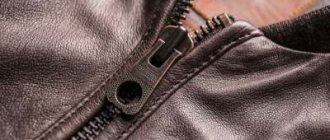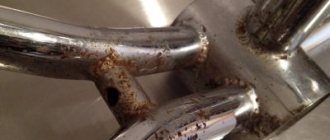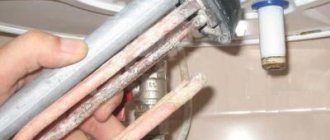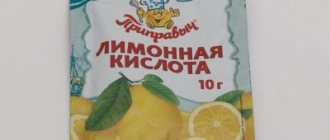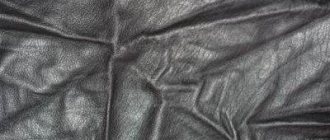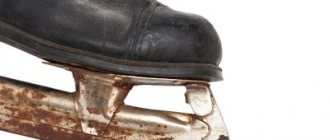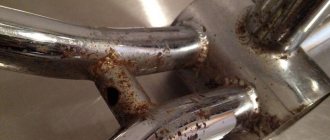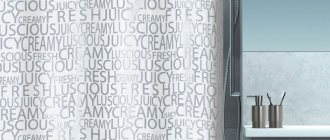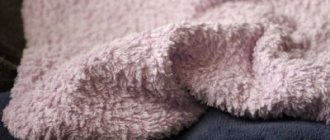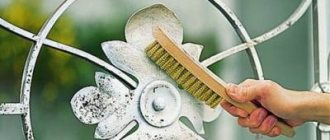Therefore, timely removal of rusty deposits and the use of preventive measures are mandatory elements of knife care. For these purposes, home methods or ready-made chemical solutions are used.
Read the article about how and with what to remove rust from a knife at home and restore its original appearance.
How to restore the original appearance of a product using folk remedies?
Iron oxides and hydroxides that appear on the surface of a steel blade can be easily removed using homemade “reagents.” Such products are valued for their ease of use and affordable price .
Vinegar and lemon juice
These products contain organic acids (acetic and citric), which actively interact with iron oxides. The resulting salts are easily washed off the metal surface, restoring its cleanliness and shine. Chemical cleaning is considered one of the most effective ways to combat rust.
The instructions for using the lemon-vinegar mixture are simple:
Vinegar (6-9%) is mixed with lemon juice in a volume ratio of 1:1.- Generously moisten a cloth in the resulting solution.
- Wrap the knife blade in a cloth soaked in liquid.
- Leave the product for one hour for the reaction to occur.
- Wipe the blade with a sponge, rinse and wipe dry.
When cleaning at home, it is not recommended to use vinegar essence. The entire procedure using vinegar must be carried out with the window open or under a hood.
Read this article about using vinegar against rust.
How to get rid of it with tomato paste?
A natural tomato product has a mild anti-corrosion effect. The effect is also based on the content of acidic substances in the product.
If you don't have tomato paste, you can replace it:
- fresh tomatoes,
- tomato juice,
- ketchup.
To remove oxides, tomato paste is applied to the blade in a continuous layer. Leave for 40-50 minutes, then wipe with a sponge or cloth. If the spots have not disappeared 100%, repeat the procedure.
This home remedy compares favorably with analogues in its safety and ease of use. However, it only helps get rid of small rust stains that have recently appeared. To remove thick deposits, it is recommended to use a stronger cleaner.
Coca Cola
The carbonated drink is a popular means of cleaning rust from metal surfaces.
Phosphoric acid contained in drinking liquid is an active rust converter.
The method using Coca-Cola (Pepsi, Fanta or other similar drinks) is in demand due to its high efficiency and availability.
Coca-Cola is poured into a low container, the product is placed in it and left for 30-40 minutes . After the specified time, check the result by lightly rubbing the blade with a sponge. If orange traces remain on it, the exposure time is extended by another 15-20 minutes.
Read about the use of Coca-Cola against rust in this article.
How to remove plaque with Vaseline and lactic acid?
The combined product helps clean the blade from rust and at the same time protect it from re-corrosion. Lactic acid acts as a purifier, which neutralizes the oxide by forming it into iron lactate, soluble in liquid paraffin.
The product is prepared by mixing one portion of Vaseline paste with two portions of lactic acid. This mass is distributed over the blade and held for half an hour. Then apply petroleum jelly to a cloth napkin and wipe the knife with it, removing any remaining rust.
The method is considered effective, but its use is somewhat limited due to the fact that pure lactic acid is not available in every home. To prepare an anti-corrosion agent, instead of Vaseline paste, you can use wax or paraffin .
Vegetables
This category of cleansers includes potatoes and onions. The juice that tubers and bulbs secrete contains organic substances of an acidic nature. They are the ones who determine the high efficiency of this method. To make cleaning easier, use salt, baking soda or laundry soap as additional ingredients.
The cleaning procedure is as follows:
- Cut the potato or onion in half.
- Sprinkle the cut with salt, soda or planed soap.
- When juice appears on the cut, wipe the knife with a vegetable slice.
- Leave the product on the blade for 30-40 minutes.
- Wipe the knife with a sponge, removing any remaining marks.
If necessary, during cleaning, the blade is re-moistened with potato or onion juice to prevent the surface from drying out.
Rust is the process of metal oxidation
If you put any metal object in a damp and damp room for several days. Then, after a certain time, we will find it covered with a small reddish coating. This will be the process of iron oxidation.
At high humidity, droplets of water from the air will settle on this object. And under the influence of oxygen, the oxidation process will occur.
The most interesting thing is that it is enough for a small area of rust to appear, it will grow. And this happens due to the fact that the stain itself becomes porous, and it will absorb moisture from the air.
And in this way the entire metal object can “burn out”. It’s not for nothing that all iron objects on the street are painted. This is rust protection.
And in order for a metal object to last longer, it must be properly cared for and, if possible, coated with special anti-rust compounds. This principle absolutely also applies to knife blades. Unless it's stainless steel.
How to clean with special compounds?
Knife owners who do not trust folk recipes or, for subjective reasons, prefer to use household chemicals, can choose a product from the store. The range of ready-made rust converters is quite wide. The most popular are time-tested liquids and concentrates.
Adrilan
The Russian product, positioned as a fruit gel , is intended to remove rust marks from the surface:
- metal utensils,
- tool,
- plumbers.
The gel does not contain abrasive particles and does not damage the surface. In addition to the anti-corrosion effect, Adrilan has a disinfecting effect.
The gel is evenly applied to the surface of the blade and left for a short time. Then the brown mass is removed from the blade with a brush and washed with water. A bottle weighing 0.664 kg sells for an average of 80 rubles.
AVS AVK
A liquid product containing active zinc ions, inorganic acids and functional additives in the formula . Zinkach is suitable for cleaning steel and cast iron products from a layer of rust up to 80 microns thick. The zinc converter further protects the metal from repeated corrosion.
Shake the contents of the bottle before use. If necessary, remove the loose layer of rust. Next, apply the product evenly to the blade. Leave for 30 minutes and apply a second layer. The cost of a small 60 ml bottle is on average 50 rubles.
RUNWAY
Professional rust remover and converter made in America. Can be used for any metal surfaces, except galvanic ones . RUNWAY is used for domestic and industrial purposes.
The product is applied to the metal surface for several minutes. Remove any deposits that have formed and dry the surface. A small bottle (30 ml) sells for 90-110 rubles. A larger bottle (120 ml) is estimated at 220-250 rubles.
How to care so that the knife does not rust
How to prevent a knife from rusting is a completely natural question. And there is only one answer - proper care and timely prevention.
- It doesn’t matter what kind of knife you have - kitchen, hunting, decorative or homemade, it is necessary to periodically apply a layer of special wax to it. Collectible instruments that are not used at all are especially susceptible to corrosion.
- If the knife is intended for personal purposes, then try to use it as often as possible - this way the tool will be processed naturally.
- After routine cleaning, be sure to wipe the knives dry and treat them with acetone or alcohol.
If a knife rusts in your house, what to do and how we described it in the article. With the help of our tips, you can restore the original shine and beauty of your cutlery quickly and easily. But it’s better not to allow corrosion into your kitchen, but to take care of household items in a timely manner. Follow preventive measures and you will never see destructive rust in your home.
What can't be used and why?
Do not use too aggressive preparations to clean the blade and mechanism of the knife . If you have doubts about the product, before use it is recommended to apply one drop to the edge of the product to track the reaction and see the result.
GOI paste should be used with great care for polishing. It gets stuck in the smallest cracks and cavities, from where it is difficult to remove.
This is especially true for antique knives that have carved steel handles. It is better to entrust the cleaning of such items to specialists.
Professional products
If the previous options did not help, you will have to use the products offered by manufacturers of household chemicals. If the blade has a completely neglected appearance, then you first need to clean the blade from pieces of rust, which are already like petals. And then go over it a little with sandpaper to facilitate the action of special reagents.
As already mentioned, you need to work with chemical compounds quite carefully, wearing gloves and preferably a respirator. Now, for convenience, these products are sold in the form of sprays, aerosols and foam.
There are rust converters, they help metal oxide become more dense and prevent its further spread. But rust removers are different in principle.
When using both, you must strictly follow the instructions and do not exceed the time of use. Do not mix different reagents under any circumstances - the result may simply be unpredictable. You may get a chemical burn or injury.
How to protect the blade from corrosion?
To avoid the problem of rusty deposits appearing on a knife blade, it is necessary to protect the steel from exposure to adverse factors .
First of all, they include moisture. Immediately after use, knives should be washed and dried with a towel.
Prevention requires compliance with storage rules . Sharp instruments are stored in oiled paper or special stands. This must be done for safety reasons, as well as to protect the blade from moisture.
If the knife is used for technical purposes, it can be wiped with kerosene. If it is not possible to use this substance, the blade is covered with a thin layer of wax.
To prevent the onset of corrosion and apply the cleaning agent in time, it is recommended to use the knife as often as possible.
Even decorative items hidden in sheaths require periodic inspection .
If water gets into the folding knife hinge, it is advisable to remove it with a hair dryer. Otherwise, the inaccessible damp area will be where corrosion begins.
Causes of rust
- Firstly, inattention to the product during operation. The knife is either forgotten on the street and exposed to rain for a long time, or is not systematically wiped after washing.
- Secondly, improper use of dishwashers. Many people place utensils with food residues in the drum, which is not recommended, because as a result the metal oxidizes.
- When using dishwashers, sometimes the integrity of the internal rubber bands is damaged, resulting in the formation of rust in the unit, which, circulating in the drum during washing, settles on the devices, sticking to their surface.
- Rusty water pipes can also cause plaque to form during cleaning. In this case, nothing short of a major plumbing repair will help.
- A “violent” reaction also occurs when alloys frequently interact with fruit acids, salt, and vinegar.
Additional Tips
You can use any suitable method to remove rust marks from a knife. When choosing a product, you should focus on the degree of contamination, financial costs and the possibility of using the method.
In any case, it is advisable to take into account additional recommendations that will facilitate the cleaning process and help speed it up:
If the rusty coating is significant and has not disappeared completely after the first treatment, it is necessary to repeat the cleansing with the same product or choose a different one.- If the corrosion process has gone far and a solid, dense coating of rust has formed on the knife, then it is advisable to first remove it mechanically (with sandpaper), and then complete the cleaning with any liquid agent.
- When using any chemical reagents, it is necessary to wear rubber gloves to protect your skin.
- After complete removal of rusty traces, the blade is thoroughly washed with water and dried well. The presence of moisture can reinitiate corrosion.
Cleaning knives with chemical reagents
Well, after trying some of the methods from popular recommendations, and if the result was not achieved, you can resort to the help of potent reagents. Most often, such methods are resorted to in case of severe corrosion damage.
These methods can also be called partly folk, but they can be quite effective. Such methods are much more aggressive and the result can be seen in a short period of time.
It is better to use them with rubber gloves and try not to inhale the fumes released. Let's try to describe three ways:
- Zinc chloride, potassium hydrogen tartrate. To perform this procedure, you will need 100 ml. water in which you need to dissolve 0.5 grams of potassium hydrogen tartrate and 5 grams of zinc chloride. When the reaction begins, lower the blade there and, as with the method using Alka Seltzer, wait for the reaction to complete, but in this case the knife will have to wait about 2-3 hours. Once the reaction is complete, remove the wedge and wipe dry with a cloth.
- C hydrochloric acid. When using such strong acids, by the way, instead of hydrochloric acid, you can use sulfuric acid. You need to be especially careful and attentive; special inhibitors are used with them to reduce the destructive effect on the metal. Otherwise, the blade will “eat” up to the hilt. The solution should be 5% acid and methenamine (0.5 grams per liter). Then the knife is treated with a brush or rag well soaked in this mixture.
- And Lka seltzer. The drug for headaches after a stormy feast turns out to have other useful chemical properties. You will need 5 tablets of this drug. We lower them into the container, and then fill them with water, dip the rusty blade into it and keep it there until bubbles appear. As soon as the boiling process is over, remove it and remove any remaining dirt with a soft cloth.
Removing rust from a knife using chemicals.
Working with such chemical compounds yourself can be dangerous. It is unknown what reaction can occur if the proportions are mixed incorrectly. And where to get some of the reagents, you may not be able to find them in the public domain.
For this, various manufacturers of household chemicals have developed a whole line of rust removers.
Chemical properties of rust
In order to understand the principle of action of rust cleaning agents, you need to know what it is by nature. Chemically, it is iron (III) hydroxide, an insoluble base that is neutralized by acid. Therefore, in order to remove rust stains from a knife blade, it is necessary to treat it with a substance containing acid. Among the usual means at hand, we can recall:
- potatoes (contains oxalic acid);
- onions (various organic acids);
- vinegar (acetic acid).
There are other options that can help you get rid of this problem. Much depends on how severe the damage is. Perhaps this is a light coating, or perhaps corrosion has already formed serious pits on the smooth surface of the blade. One way or another, in order to clean a knife from rust, remove existing stains and protect it from the appearance of new ones, you need to go through all stages of the procedure.
Measures to prevent corrosion
The price of the knife has no effect on the rusting process. A blade worth several thousand rubles will become unusable, just like cheap Chinese knives. No one has canceled chemical processes. And there are many reasons for them:
- After washing the product, wipe it with a towel or napkin until completely dry.
- A room with high humidity negatively affects the condition of the knife. This also applies to the location of sharp-nosed assistants in the kitchen. They should be placed away from the sink .
- After using the blade, it must be washed thoroughly . Especially after cutting vegetables and fruits, they contain natural oxidizing agents.
- A blade covered with small scratches is most susceptible to rust . They accumulate tiny particles of water and products that are difficult to remove with a napkin or towel.
- An eraser will help prevent rust from spreading throughout the entire product. If you find a small stain, you should immediately try to wipe it off . If the method does not help, you will have to take more serious methods.
The ability of rust to spread from one small focus over the entire surface is a primary problem. Having discovered a stain, you must react immediately.
Various situations arise, and laying a straw where you fall is not always possible. It is better to prevent trouble than to solve it later.
Knives for various purposes are susceptible to rust. Homemade and factory-produced steel for hunting blades has good characteristics for cutting and skinning prey. But it is often subject to elementary corrosion. The problem lies in the cleanliness of the scabbard.
Hunter's blade with traces of rust.
Having hastily inserted a once-stained knife into them, the process began. Wiping the blade with a rag will not correct the situation. When sheathing the blade, it will be exposed to a dirty and damp environment. By the end of the hunt, the product will undergo an irreversible rusting process.
Rough cleaning of a knife from rust
A rusty blade can be sanded
Before starting work, you should assess the degree of damage: how much the steel has oxidized and what is the surface area affected by rust. Rough cleaning makes sense when there is severe oxidation. Using tools you can only get rid of the top layer of rust. Remaining deposits will have to be removed using cleaning agents.
Mechanical work is carried out according to the general scheme:
First, the oxidized metal must be prepared and softened. To do this, use non-aggressive means, for example, kerosene or white vinegar. The reagent is poured into a mug and a rusty knife is kept in it for 10 - 15 minutes. Then you can start cleaning. If the layer of dirt is thick enough, you will have to use a chisel with a small hammer or similar tools. You should beat it carefully, trying not to damage the metal. Any remaining oxidation particles should be sanded off with sandpaper. A metal brush, sold in a hardware supermarket, is also suitable for removal. It is not recommended to use sandpaper if the deformed layer of iron is too thin
Such cleaning inevitably causes scratches, which in turn accelerates corrosion processes. If there is severe contamination by deposits, electronic devices will help, the hydrolysis method is the combined use of a solution with reagents and a device that passes current through it. At the last stage, it is important to ensure that there is no dust or particles of abraded deposits. If they remain, corrosion will appear and grow again.
If done correctly, the knife will look like new.
Removing rust using electrolysis
The method is effective, but dangerous. Therefore, it should be used only in the most necessary cases, if rust cannot be dealt with using folk remedies and special chemicals.
To remove corrosion, proceed as follows:
- Fill a plastic container with warm water.
- Add 2 tbsp. l. soda or salt.
- Get a car battery charger.
- Attach a metal plate to one wire, and a corroded object to the other.
- Place both ends in the container and turn on the device for half an hour, setting the current to 4–6 amperes.
- Remove any remaining rust with a brush or sponge.
Anti-corrosion agent with zinc
It is sold in spray bottles and has no worse effect on corrosion than acid solutions.
- Before treating with the product, walk over the surface of the knife with iron wool or fine-grained sandpaper.
- Rinse with running water.
- Degrease with an alcohol solution. This creates an optimal environment for the interaction of zinc with metal, during which rust is removed from the knife.
- Use plastic or glass containers for long-term soaking if the surface of the blade is deeply damaged.
- For small stains, apply two coats with a spray bottle (you can use a brush). The first layer is a primer. It dries in 5 – 10 minutes. The second one is applied next.
- Remains of rust from the knife are removed with a scraper.
